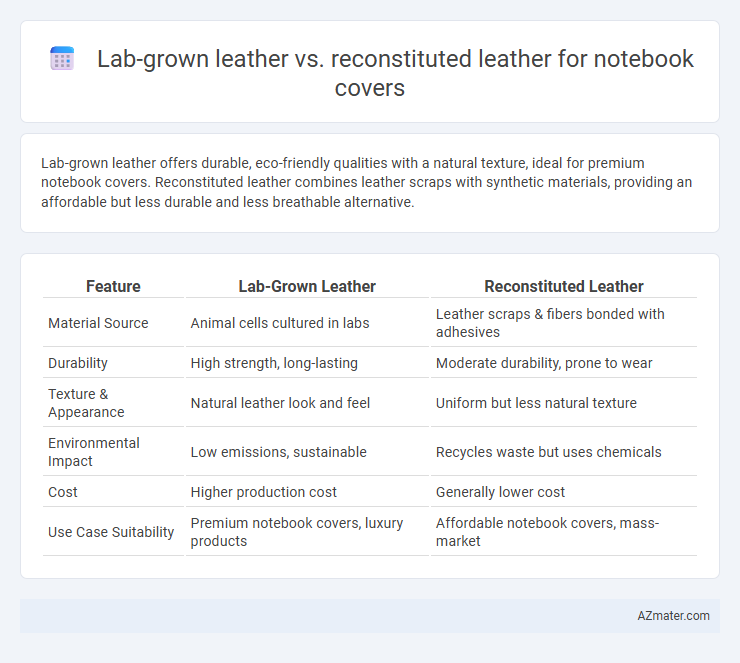Lab-grown leather offers durable, eco-friendly qualities with a natural texture, ideal for premium notebook covers. Reconstituted leather combines leather scraps with synthetic materials, providing an affordable but less durable and less breathable alternative.
Table of Comparison
| Feature | Lab-Grown Leather | Reconstituted Leather |
|---|---|---|
| Material Source | Animal cells cultured in labs | Leather scraps & fibers bonded with adhesives |
| Durability | High strength, long-lasting | Moderate durability, prone to wear |
| Texture & Appearance | Natural leather look and feel | Uniform but less natural texture |
| Environmental Impact | Low emissions, sustainable | Recycles waste but uses chemicals |
| Cost | Higher production cost | Generally lower cost |
| Use Case Suitability | Premium notebook covers, luxury products | Affordable notebook covers, mass-market |
Introduction to Alternative Notebook Cover Materials
Lab-grown leather, crafted from cultured animal cells, offers a sustainable and cruelty-free alternative to traditional leather for notebook covers, boasting durability and a natural texture. Reconstituted leather, made from shredded leather fibers bonded with polyurethane or latex, provides an eco-friendly option that repurposes leather waste while maintaining a leather-like appearance. Both materials present innovative solutions in alternative notebook cover production, balancing environmental impact and functional aesthetics.
What is Lab-Grown Leather?
Lab-grown leather is a sustainable alternative to traditional leather, created through cellular agriculture by cultivating animal cells in a controlled environment. This innovative material replicates the texture, durability, and breathability of genuine leather without the environmental impact of livestock farming or tanning processes. For notebook covers, lab-grown leather offers a cruelty-free, eco-friendly option with premium quality and long-lasting performance.
Understanding Reconstituted Leather
Reconstituted leather, also known as bonded leather, is made by shredding genuine leather scraps and binding them with adhesives to create sheets suitable for notebook covers. This material offers a more affordable and sustainable alternative to traditional leather without sacrificing a leather-like appearance or texture. Unlike lab-grown leather, which is bioengineered from collagen proteins, reconstituted leather relies on recycling real leather fibers, making it a cost-effective choice for eco-conscious stationery products.
Production Processes Compared
Lab-grown leather is created by cultivating animal cells in a controlled environment, resulting in a material nearly identical to traditional leather but without the need for animal slaughter. Reconstituted leather, also known as bonded leather, is produced by shredding genuine leather scraps and combining them with polyurethane or latex binders to form sheets. The lab-grown process emphasizes bioengineering and sustainable resource use, while reconstituted leather relies heavily on recycling post-consumer leather waste and chemical adhesives.
Environmental Impact Analysis
Lab-grown leather offers a significantly lower environmental footprint compared to reconstituted leather, reducing water usage by up to 90% and carbon emissions by approximately 60% during production. Reconstituted leather, made from leather scraps combined with synthetic materials, often involves chemical binders and adhesives that can contribute to pollution and hinder biodegradability. Choosing lab-grown leather for notebook covers supports sustainable manufacturing practices by minimizing waste, lowering greenhouse gas emissions, and enhancing resource efficiency.
Durability and Longevity
Lab-grown leather for notebook covers offers enhanced durability due to its uniform cellular structure and resistance to wear and tear, often outperforming traditional materials in longevity. Reconstituted leather, while more economical, tends to have a shorter lifespan because it comprises shredded leather fibers bound by adhesives, which can degrade over time and cause peeling or cracking. Choosing lab-grown leather ensures a more resilient and sustainable option, maintaining structural integrity and aesthetic appeal for extended use.
Aesthetic Qualities and Customization
Lab-grown leather offers a smooth, uniform texture and a rich color depth that enhances the premium aesthetic of notebook covers, while providing greater flexibility in dyeing and embossing techniques for high customization. Reconstituted leather features a more varied, natural grain and can incorporate intricate patterns or logos through printing, though it may have inconsistencies in surface finish that affect visual appeal. Both materials allow for tailored designs, but lab-grown leather excels in achieving consistent, luxury finishes suited for upscale notebook covers.
Cost Differences for Consumers
Lab-grown leather typically incurs higher production costs due to advanced biotechnological processes, making notebook covers with this material more expensive for consumers. Reconstituted leather, composed of bonded leather scraps and synthetic binders, offers a more budget-friendly alternative without compromising durability. Consumers seeking eco-conscious options with lower price points often prefer reconstituted leather notebook covers over lab-grown leather.
Sustainability and Ethical Considerations
Lab-grown leather for notebook covers offers significant sustainability advantages by reducing reliance on animal agriculture, lowering greenhouse gas emissions, and minimizing water usage compared to traditional leather. Reconstituted leather, made from leather waste and synthetic materials, promotes circularity by repurposing scraps, yet often relies on plastics that may impact biodegradability. Ethical considerations favor lab-grown leather as it avoids animal harm entirely, whereas reconstituted leather still involves animal-derived inputs, making lab-grown options a more animal-friendly and environmentally conscious choice.
Which Leather is Best for Notebook Covers?
Lab-grown leather offers superior durability, water resistance, and eco-friendliness compared to reconstituted leather, making it ideal for notebook covers that require long-lasting protection and a premium feel. Reconstituted leather, created from leather scraps bonded with adhesives, tends to be less durable and more prone to cracking over time, limiting its usefulness for high-quality notebook covers. For users seeking sustainable, tough, and aesthetically pleasing materials, lab-grown leather is the best choice for notebook covers.

Infographic: Lab-grown leather vs Reconstituted leather for Notebook cover
 azmater.com
azmater.com